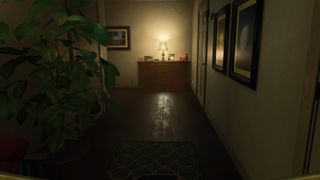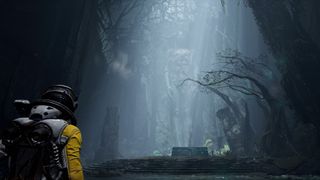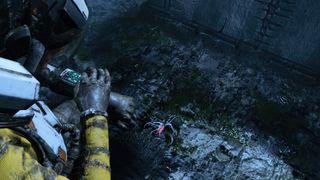
Sony’s PS5 games lineup has seen two major additions recently: Returnal and Resident Evil Village. And while both games may differ greatly in their offering – Returnal being a challenging third-person sci-fi shooter and Resident Evil Village a survival horror – there’s one major feature that botht titles have in common: their spectacular utilization of PS5 3D Audio.
First revealed by PS5 lead architect Mark Cerny back in early 2020, PS5 3D audio makes use of Sony’s innovative Tempest 3D audio engine to make PS5 in-game audio spatial. What that means is that, rather than a player hearing sound as one stereo block, like with the PS4, each sound is delivered to players as though it’s coming from the source itself. The aim is ultimately to create a more immersive, realistic in-game audio experience – and Sony seems to be delivering.
In our reviews of both Returnal and Resident Evil Village, we lauded the implementation of PS5 3D audio. Whether it was the soothing pitter-patter of raindrops on a helmet in Returnal or the ghastly rasps of an approaching adversary in Resident Evil Village, we found Sony’s new audio tech provided extra depth to our gameplay experience that we didn’t quite know we needed.
With audio seemingly becoming more important this generation than in previous, we spoke with Sony Interactive Entertainment, Housemarque and Capcom about PS5 3D audio’s role in adding dimension to Returnal and Resident Evil Village.
- Check out our PS5 Pulse 3D Wireless Headset review
- Best PS5 headsets 2021: because sound matters
Adding immersion to horror

If you’re looking for a showcase in how the PS5 3D audio system can truly elevate a game, then look no further than the Beneviento House sequence in Resident Evil Village. While we won’t spoil the finer details of what takes place within the dollmaker’s house, we will say that it’s probably the best sequence of Village, made even better by the use of 3D audio on PS5 – which requires you wear headphones.
"I want players to be able to enjoy the experience of encountering a new enemy, even before they’ve visually chanced upon it. I believe 3D audio has the specs to really amplify what we’re aiming for."
Wataru Hachisako - Capcom
The Beneviento sequence relies on the sheer fear of the unknown and its ambience, with the player aiming to solve puzzles – unarmed – in a darkened house with a plethora of unidentifiable sounds resonating around you. The fear lies in what the audio suggests you might see, rather than what’s in front of you – and that’s exactly what Capcom was aiming for.
“It’s very important in the horror genre to apply fear to the player’s imagination through elements they cannot see,” Wataru Hachisako, Audio Director on Resident Evil Village at Capcom told TechRadar. “I want players to be able to enjoy the experience of encountering a new enemy, even before they’ve visually chanced upon it. I believe 3D audio has the specs to really amplify what we’re aiming for.”
Get the best Black Friday deals direct to your inbox, plus news, reviews, and more.
Sign up to be the first to know about unmissable Black Friday deals on top tech, plus get all your favorite TechRadar content.
Capcom’s use of PS5 3D audio adds an extra dimension to Resident Evil Village’s horror, fluidly changing alongside the game’s environments and making them feel more – like you’re actually there yourself. This is brilliantly realized in the restrictive hallways of Castle Dimistrecu’s dungeons, where you can hear the echoes of a drip far in front of you and a screeching creature ahead, as well as in the main Village itself, a wide-open space where the player is surrounded by sounds from all angles - the latter actually proving to be more terrifying due to that sense of the unknown.
“We not only wanted to make Resident Evil Village visually grand and spectacular, but we also wanted to have a variety of areas and spaces,” Hachisako tells us. “3D audio is incredibly important in conveying proper spatial perception. By adding 3D audio to the presentation, greater detail and depth is added to the graphics, and players will also sense subtler differences in the depth and feel of all the different areas they encounter.
“It’s also an important element in story progression. Whether it’s a cold winter breeze rattling a rooftop, the absence of sound that hides the presence of something hiding in the darkness, an adversary that jumps in front of the player, or the peaceful melody of the safe room, all of these elements are distinct and more profound with the addition of proper audio and music. By syncing up spatial perception and plot progression, it amplifies each element and 3D audio is really able to provide the player with a more impactful experience.”
But not every audio experience is one that players want - or ought to - experience. Hachisako admits that there were some sound effects that were “a little too grotesque and realistic” to keep in Village, resulting in them being removed altogether or simply toned down a bit. “There are also some sounds of metal or wood rubbing together or clashing which puts some people’s teeth on edge, so we had to take care with the 3D audio positioning of those,” Hachisako explains.
Bringing VR audio to Returnal

While Resident Evil Village’s 3D audio is a tantalizing bonus for those who play on PS5 - with Capcom’s latest offering available on a plethora of other platforms - Sony’s new audio tech is interwoven with PS5 exclusive Returnal.
In our review of Returnal, we called Housemarque’s third-person roguelike “one of the most immersive gaming experiences we’ve enjoyed to date, outside of VR”, citing the title’s combination of DualSense and 3D audio implementation as a key factor in this.
"The immersive audio approach has given us a powerful new tool to guide players through the battles. We are of course looking at creating visual guide posting so players can rely on only visuals to know where the action is, but with the addition of 3D audio the reactions become much more intuitive."
Loic Couthier - SIE
Housemarque’s utilization of PS5 3D audio is truly stunning. Not only did the developer take into account the spatiality of audio, but how different perspectives would affect that sound. Take, for example, the sound of rain on protagonist Selene’s helmet. In the game’s primary third-party view, you can hear the sound of raindrops all around you as well as the sound of raindrops on Selene’s suit and helmet - meaning you can hear each individual drop from the point it is falling at in relation to Selene’s position. However, in the first-person view, you can hear these raindrops from her ears’ perspective, with the helmet rain switching from a tiny point source to an expanded surrounding sphere.
“The environmental sounds of rain derive from drops hitting the ground, but this is also filtered through the helmet, so you hear it differently,” Loic Couthier, Audio Lead on Returnal at SIE tells us. “That is true for all environmental sounds.”
“For the support of the narrative and gameplay, we allow sounds to be heard much more clearly and naturally similarly to what it would sound like with a real space helmet,” Couthier continues. “Selene’s voice is a great example. In first-person, you will hear Selene’s voice and breathing from inside the helmet. We recorded the 3D sonic signature of a helmet (called an impulse response), which we leverage to process the game sounds through, in real time. Selene’s voice comes from her mouth, but is “traveling and resonating” within the helmet, which with 3D audio feels like you are inside the helmet.”
But it’s not just real-time processing that is bolstered by PS5 3D audio, Couthier also praises how Sony’s new tech allows for improved verticality perception, calling it “the third dimension that was previously missing”. Verticality perception allows players to hear if a sound is coming from above or below them, with most surround sound audio systems only indicating if a sound was behind, in front or to the side of you. In practice, it means that you can hear when Returnal’s many flying enemies are above your head, and where - in relation to Selene - they are located.
While Housemarque is primarily known for its work on arcade shooters such as Resogun and Nex Machina, the Finnish studio is also an old hand at utilizing 3D audio and verticality, having spent six years developing PSVR games like Super Stardust Ultra VR.
“In 2D experiences, we usually look at creating dynamic scenes where the atmosphere follows build up of action and tension,” Mikael Haveri, Biz Dev and Marketing Director at Housemarque explains. “The whole idea is to create a good mix of all the audio elements, and they work as indicators of different events, but the direction of the sound has always been more or less confined to a stereo mix.
“The immersive audio approach has given us a powerful new tool to guide players through the battles. We are of course looking at creating visual guide posting so players can rely on only visuals to know where the action is, but with the addition of 3D audio the reactions become much more intuitive.”
With Returnal, Housemarque hopes that players listening out for detailed audio cues - like an enemy charging up a powerful attack - will become “second nature”, allowing them to focus on the combat - trusting the game’s audio to indicate threats.
Creating iconic sound

But 3D audio can only take a game’s audio experience so far, the core audio experience needs to be brilliant in its own right. Resident Evil Village is a great example of this, given that only its PS5 version makes use of 3D audio, its key that Capcom still provides a riveting experience for those without access to Sony’s latest console. While Housemarque has only a PS5 player base to serve with Returnal, the developer’s vast experience in varying audio landscapes has taught it the key to making iconic audio.
“Creating an iconic sound effect is a combination of many factors,” Couthier explains. “Whilst luck can be a part of any creative process, it’s more of a stylistic exercise.
“Some of it is science. For example, I believe an iconic sound needs to be tonal and/or rhythmic. It needs a memorable pattern. Tonality gives emotional impact. Star Wars sounds, THX deep notes, Mario’s moves, Metal Gear Solid alert sounds for example, those are all tonal sounds. You can remember them because you can ‘sing’ them with your mouth. They are musical. Rhythm is another way to have a sound that gets imprinted into your memory, because you can memorize the specific pattern, like a little drum roll.
To be iconic, a sound needs to be the signature for something really strong for the game (or movie), that is repeated a lot. You need the feature to be strong, for the sound to have a chance to be too, by association. Lastly, the sound needs to be the perfect fit. That is the hardest part I suppose, the creative making of that sound. You could make that sound in five minutes, or five months. This is where genius, luck and inspiration can be.”
Couthier believes that while 3D audio can “add spectacular value and quality with positional and enveloping detail”, the “root” of an iconic sound must work across a variety of audio systems and devices. “It really is about the very “voice” rather than the playback format,” he continues.
A greater focus on audio

Sony appears to have placed a greater focus on delivering effective gaming audio this generation than we’ve seen previously. It’s a welcome change, as we saw the Xbox One’s utilization of Dolby Atmos last generation putting the PS4 to shame. Imagine how The Last of Us 2 could have sounded with PS5 3D audio?
"With 3D games striving for more and more realism, I believe 3D audio is an added piece of technology that is definitely necessary in striving for heightened realism. Rather than playing a game as an audience member, it allows players to enter that world as one of the characters."
Wataru Hachisako - Capcom
“Each new console generation unlocks new cutting-edge technology, and PS5 has both the technology and the processing power to handle 3D audio mixes and rendering”, Couthier explains, when asked about why there’s this greater emphasis. “The other factor comes from the evolution of the craft in the industry. The previous generation has seen audio content and processing reach really high-quality standards. I like to think the quality of audio in games has reached a quality standard equal to cinema. The mediums are different, but the love of the craft and skills of designers are very high in both industries.”
While only a handful of games at present utilize the PS5 3D audio, we expect that Sony will continue to utilize the new audio tech for its upcoming first-party PS5 titles like Horizon Forbidden West and God of War Ragnarok as the desire for high-quality audio grows.
“Audio carries a significant amount of personality, emotions, and sense of satisfaction when playing a video game,” Couthier tells us. “Today, if you want to make a successful game, it must sound great with a very high standard of quality.”
While the bar for gaming audio may have been raised considerably this generation, Wataru Hachisako believes that realism 3D audio allows for is why it's become such a focus this generation. “3D audio creates a sense of space and sound that emulates real life incredibly well,” Hachisako tells us. “With 3D games striving for more and more realism, I believe 3D audio is an added piece of technology that is definitely necessary in striving for heightened realism. Rather than playing a game as an audience member, it allows players to enter that world as one of the characters.”
According to SIE, PS5 3D audio tech will continue to grow as Sony continues to gather feedback from developers and designers. “As Mark Cerny previously mentioned, the audio experience is something that will continue to evolve,” Kenichi Imai, Deputy Head of the Software Engineering Group at SIE tells TechRadar. “Going forward, we will continue to strive to provide the most immersive experiences possible on PS5 and explore ways to improve the 3D audio experience even further.”
Will this evolution include more customization options in the future? “We’re always exploring ways to deliver a more immersive experience to our players, but we have nothing to share at this time,” Imai tells us.
- Best PS5 games: the most essential PlayStation 5 titles
An award-winning games journalist, with seven years of experience in games journalism and a degree in journalism from City University, London, Vic brings experience from IGN, Eurogamer, The Telegraph, VG247, Dot Esports and more to the TechRadar table. You may have even heard her on the radio or speaking on a panel, as she’s previously appeared on BBC Radio 4, BBC Radio 5, BBC Radio Ulster and more. Not only is Vic passionate about games, but she's appeared on both panels and podcasts to discuss mental health awareness. Make sure to follow her on Twitter for more.
Most Popular

